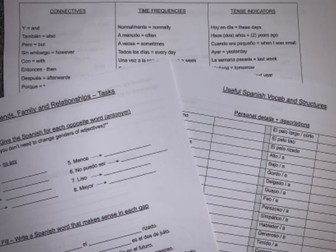French Holidays (Vacances) Starters, Speaking, Translations
<p>These tasks are quite short, but they do have more complicated French structures and tenses.<br />
So, they are appropriate for more able students in Year 9 onwards. A couple of the tasks are definitely aimed at Higher Tier GCSE.</p>
<p>Information about tasks is given on each document, but details are also below:</p>
<p><strong>Task 1: French texts for Dictation and / or Translation</strong> (I read to class and they wrote the French and then self-corrected. I asked questions about grammar, tenses etc to deepen thinking).</p>
<p>Could also be used as a Translation task and also enlarged and given to groups or put up around room for students to highlight / annotate (present / past / future verbs, connectives, opinions etc).</p>
<p><strong>Task 2: Class Speaking Activity</strong> (you may need to change number of sentence pairs according to number in class – there are 30 here)</p>
<p>Cut up each of the 2 sentences and give one slip to each student.<br />
Students stand up and one reads his/her English first. Person with French translation stands and reads that.<br />
Then, that same pupil reads English for the next person to read out the French translation and so on….<br />
Once students have read both of their English and French, they sit down.<br />
If done correctly (print a spare copy off so you can follow!) the final person to translate and sit down should be the person who started the activity </p>
<p><strong>Task 3: Holidays Starter task</strong><br />
2 of the same gap-fill Starter task on this page.<br />
Challenge / Extension can be to translate sentences afterwards and/or adapt French sentences with new details.</p>
<p><strong>Task 4 - Starter HIGHER TIER GCSE – more complex structures and tenses.</strong><br />
Categorise sentences into tense boxes.<br />
Then, translate each sentence into English.<br />
Can also adapt these sentences as an extra challenge.</p>
<p>I hope you will find these reources useful.</p>

